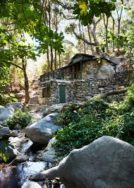
Anthony Russo’s off-grid cabin- Architectural Digest
Movie maker Anthony Russo’s off-the-grid cabin in the Angeles National Forest is high style – on the inside. On the outside it still looks like the funky C19th. building, recently rediscovered by Architectural Digest.
Russo’s getaway is one of a cluster of cabins in the San Gabriel Mountains built in the early 1900s as part of a program instituted by the U.S. Forest Service to encourage responsible land use. Accessing the site requires a 40-minute hike on unpaved foot paths that lead from a pack station down through the canyon. Anything that needs to be brought in, from groceries to building materials, must be transported by hand or pack mule. There are no sewage, water, or power lines, and no cell-phone or internet service. An antediluvian crank phone, straight out of a Hollywood period piece, connects the cabin only to neighboring lodges and the pack station.
“We had to make the most of every square foot, so the details became all-important,” designer Steven Johanknecht explains.
“This place is truly remote, away from everything, but that’s the appeal. Even with the amenities and artisanal flourishes we installed, you’re still basically out there on your own in nature,” says Johanknecht of the AD100 firm Commune Design. “The movers had to create handcarts to get all the material to the site. It took eight men hiking back and forth for days. It felt like a scene from The Ten Commandments,” he recalls, describing the extraordinary logistical challenges of executing the full-scale reconstruction project.
“The place is less than an hour from my office downtown, but you feel like you’ve traveled far, far away from Los Angeles. It’s a radically different reality,” says Russo, who, along with his brother Joe, has directed four installments in the Marvel Cinematic Universe, including Avengers: Endgame and Captain America: Civil War. “The cabin gives me the opportunity to kidnap my kids for the weekend, bring friends up, or simply do some writing and other creative work in blissful solitude,” he explains.
Russo tapped Commune Design for the assignment after admiring the firm’s work for the Ace Hotel group as well as the late, lamented L.A. restaurant Ammo. “I felt like they had the right sensibility to respect how special this place is but also the imagination to make it of today,” the director explains. “I’ve always been obsessed with Adirondack style, and that was definitely one of our touchstones, but I wanted to see where Commune would go with that idea. I didn’t want something totally old-fashioned and nostalgic,” he adds.
Johanknecht and his team responded with a scheme that balances pragmatic necessity with subtle nods to Shaker and Japanese design, Swedish and French chalets, and historic American mountain retreats. They replaced rotted redwood timbers with knotty cedar on the ceilings and reclaimed oak on the floors, and liberated the original stone fireplace from a straitjacket of paint …
